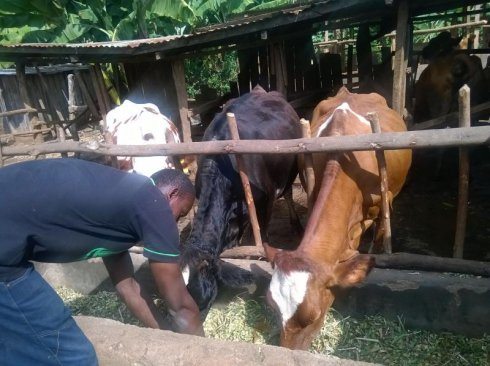Feeding Dairy Cow: Many a farmers will complain that their animals are not producing milk to their expectations. But the question they fail to ask themselves is what quality of feeds they are giving to their stock. Though not exhaustive, this article presents key feed nutrients essential to a milk producing animal.
Like any other system, input is directly proportional to output when it comes to dairy feeding and subsequent milk production. While most farmers feed their cows on available feed without considering the nutrient content or animal’s biological system’s needs; it is recommended that special feeding regime be adopted as dairy animals have relatively high nutritional demands as compared to other species as they must meet their daily body needs in addition to high milk production.
Learn from Gladys Boss Shollei’ thriving dairy farm
Not feeding your cow properly will result in inadequate milk production or can predispose it to myriad nutritional diseases. Most of nutritional diseases like milk fever are easy to prevent but they keep occurring because most farmers have inadequate information on proper dairy cow feeding. The rule of thumb is that dairy animals must be fed ad lib with feed that contains a minimum of required nutrient.
Dairy cows need high energy and protein with variations depending on age, level and stage of milk production. As milk production peaks in the 11-14th week after calving, feed intake should increase in tandem. Proteins are essential in a lactating animal as they are the main source of amino acids that go into milk protein synthesis.
Legumes like lucerne/alfafa, clovers, peas, sweet potato vines are good source protein, this can also be supplemented with fishmeal, soybeans and wheat bran.
Carbohydrates in the animal’s diet form the main source of energy for the dairy animal and are normally classified into fibrous — pasture and non-fibrous —mainly grains forms which must be balanced in the cow’s diet.
The fibre in rumen stimulates salivation and the regurgitation process when the animal is at rest. The flow of saliva creates a favourable environment for micro-organisms in the rumen which further breakdown fibrous feeds and release nutrients. Fats in sunflower seeds can be used to supplement as a source of energy.
Ruminants get a lot of their energy from grasses and grains; however be careful while using grains as they produce a lot of acid in the rumen during fermentation which can lead to nutritional disorders like bloating.
Clean water is crucial component of a dairy animal’s diet and should be served at all times to encourage its free intake. Its intake is influenced by the amount of feed and especially the salt intake, temperature and milk production.
A reduction in water intake will immediately result in low feed intake and equally low milk production. This also happens when the water is of poor quality or the animal is sick.
Apart from proteins, carbohydrates and water a dairy cow’s diet must also include the following minerals calcium, phosphorus, sodium, potassium, sulfur, chloride and magnesium.
Feeding Dairy Cow: Minerals
These minerals are required in relatively high amounts as the functions they support are critical to many physiological functions as compared to the other group called trace minerals which are cobalt, copper, iron, manganese, selenium, iodine and zinc.
Calcium is found in high quantities in milk and it is important in formation of strong bones and muscle contraction. It is found in adequate quantities in quality forage but diminishes as they age and become fibrous. Calcium deficiencies in cows are normally shown by fragile and curving of bones. It is common in systems where dairy animals are fed on concentrates or on poor forage.
Phosphorus and calcium are major minerals both forming a bulk of bones. It is important to note that when dietary phosphorus exceeds calcium, the absorption of calcium is hampered.
In case of increased demand or deficiencies in calcium or phosphorus, the shortfall is met by mobilising stored forms in the bones. If not enough calcium is available especially in early lactation, cows will develop milk fever which is characterised by recumbence.
If this is not treated in good time and effectively by a veterinary surgeon, other complications develop and death results in most cases.
Sodium supplementation using mineral links is recommended for increased feed intake; where this is lacking the cow will lick objects, drink its urine and will reduce her milk production.
Trace mineral elements are required in small quantities. The clinical signs shown by their deficiency are not distinct but they are important in proper reproduction, immunity, growth and production of your dairy animal.
For example Selenium, manganese and iodine is important for a gestating animal as its deficiency results in malformations of claves. Suckling calves will require iron supplementation as the cow’s milk is deficient in this element. Similar concerns are valid in babies fed solely on cow milk.
Supplementation can be given through mineral links which are available in the Kenyan market under various brands. And when you buy them, check if they have all these mineral elements. Lastly, we have vitamins which the dairy cow must have in its diet too. Vitamins are important in the functioning of enzymes essential in metabolism and for normal growth, production and health.
Vitamin A and E deficiency will lead to infertility and retained after birth but the good news is that because ruminants feed on greens, vitamin deficiencies are rare. Forages like caliandra have high vitamin A and E content, but this decreases with age, drying and storage. Vitamin A, D and E must be supplied in the animals’ diet. Vitamin D is readily available in green feeds or exposure to ultra violet rays.
The following feature is by Dr OthienoJoseph, a veterinary surgeon working with the Kenya Tsetse and Trypanosomiasis Eradication Council.
Visit our sister site Newsday Kenya for more!








